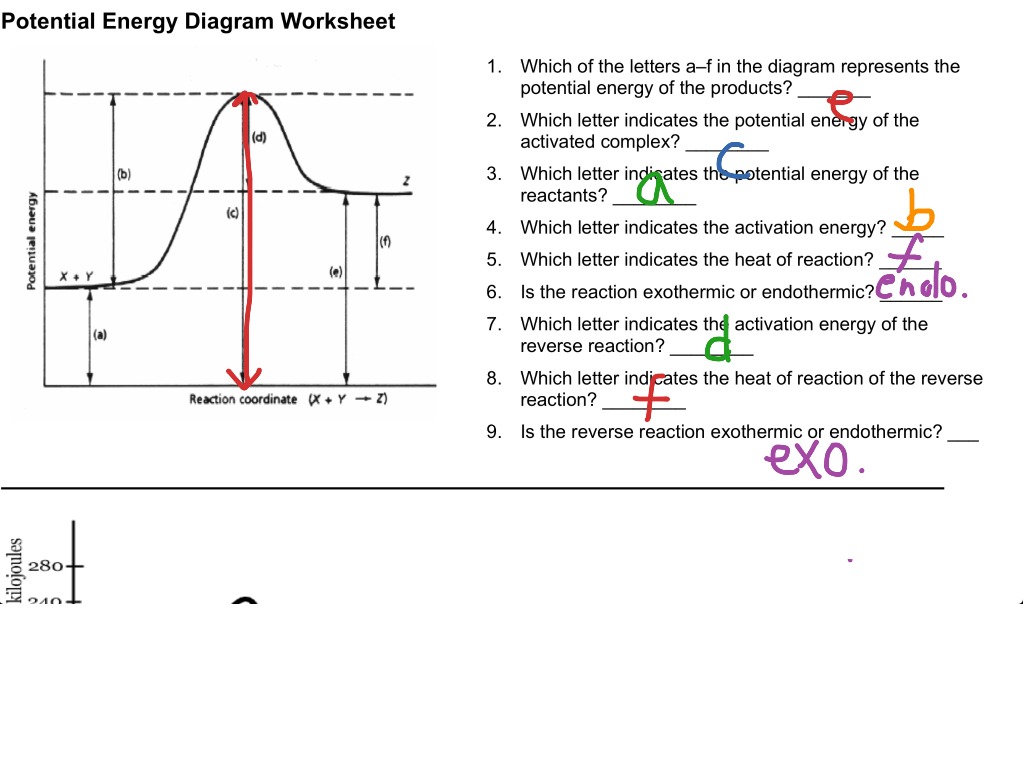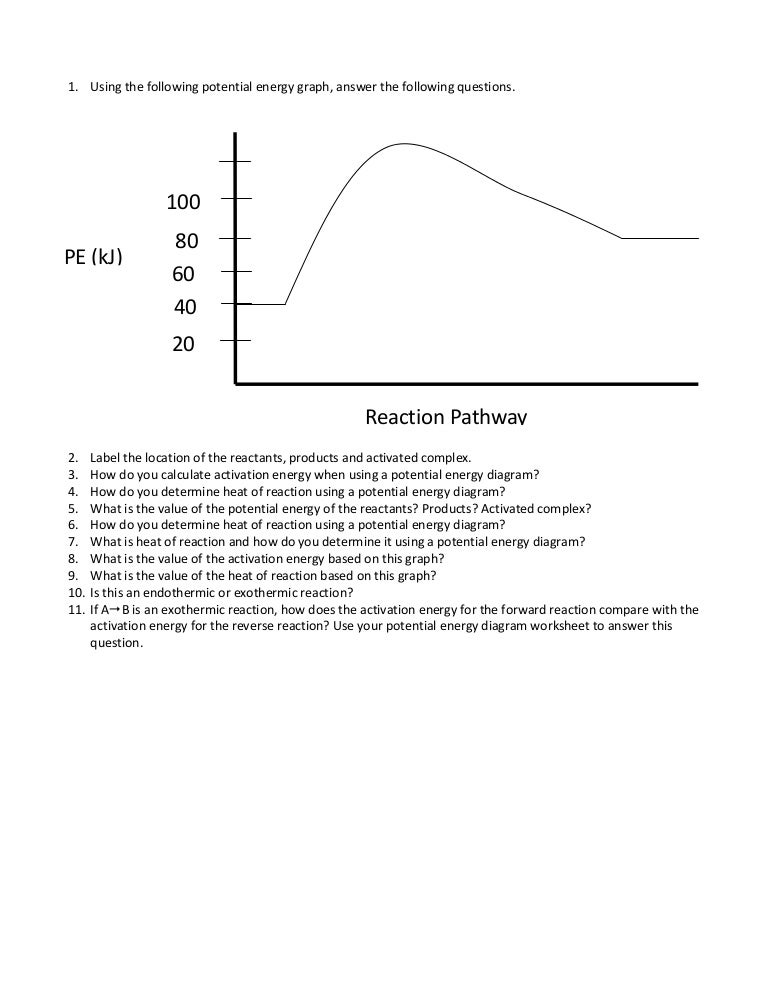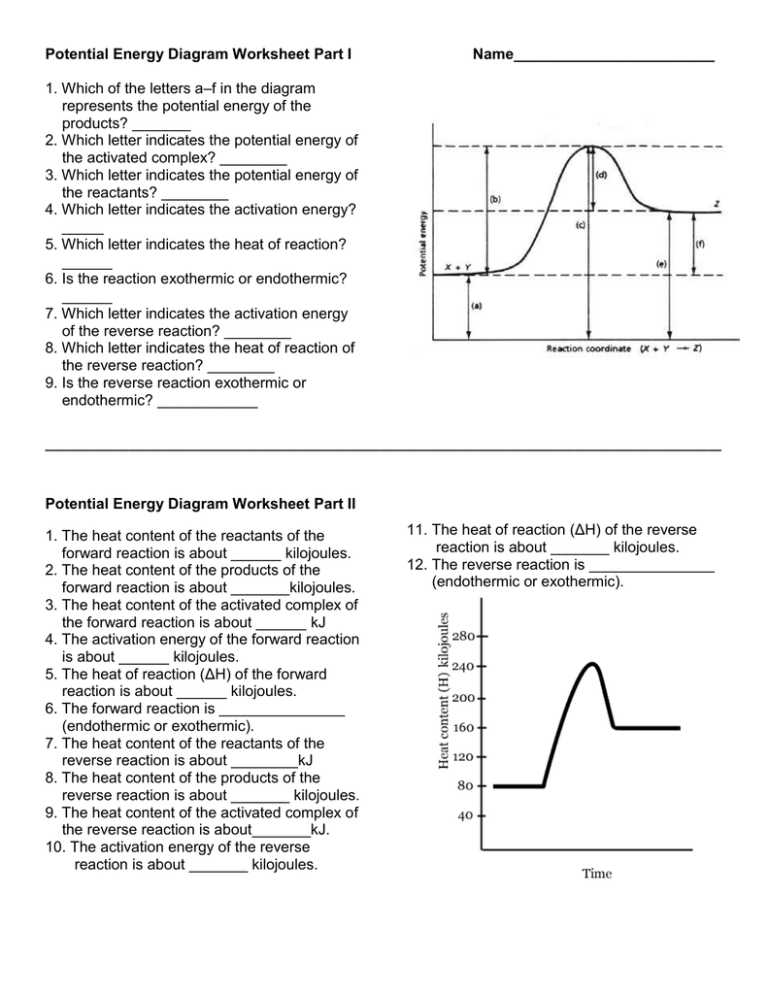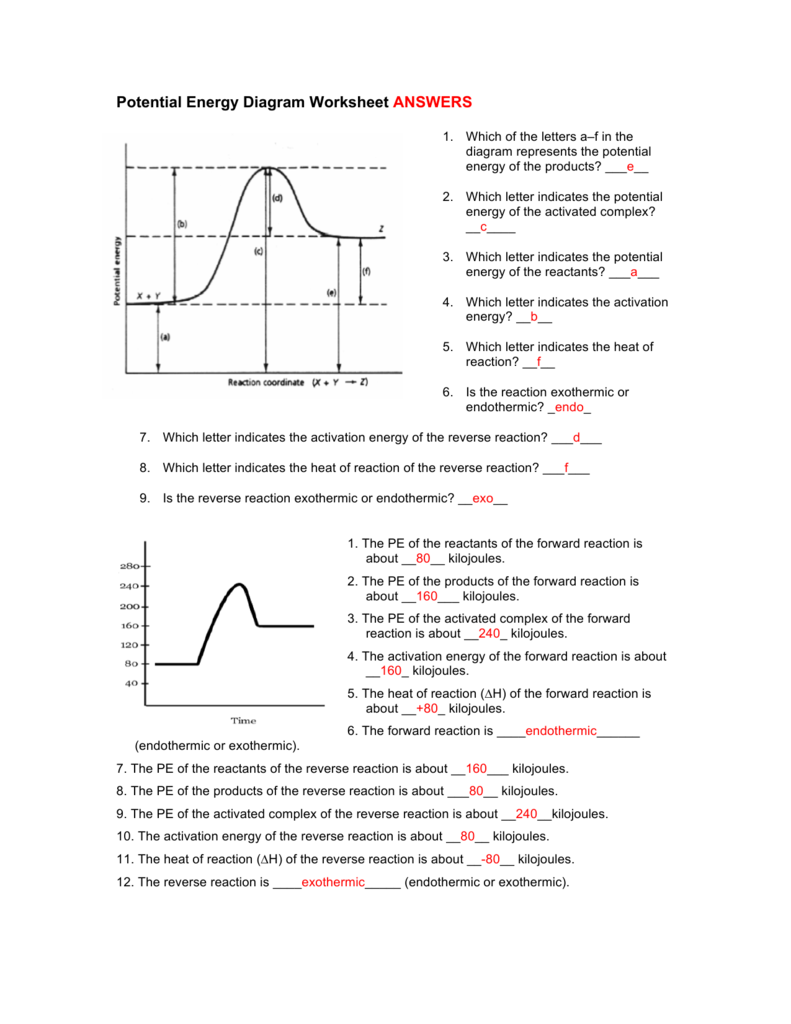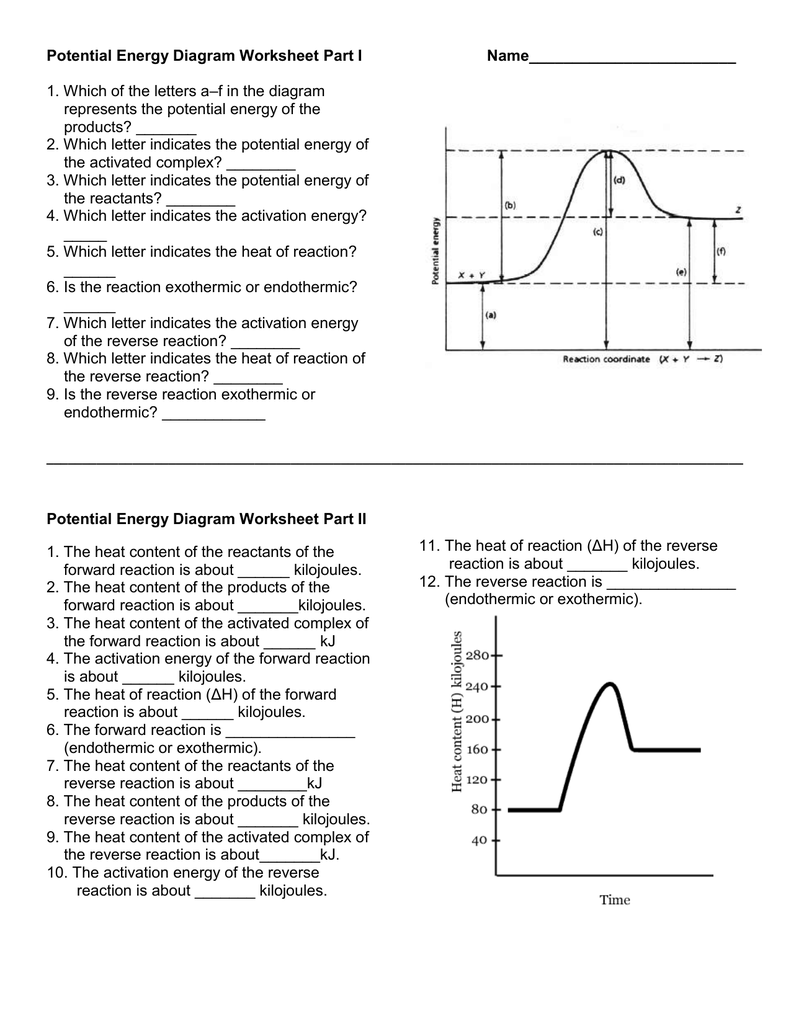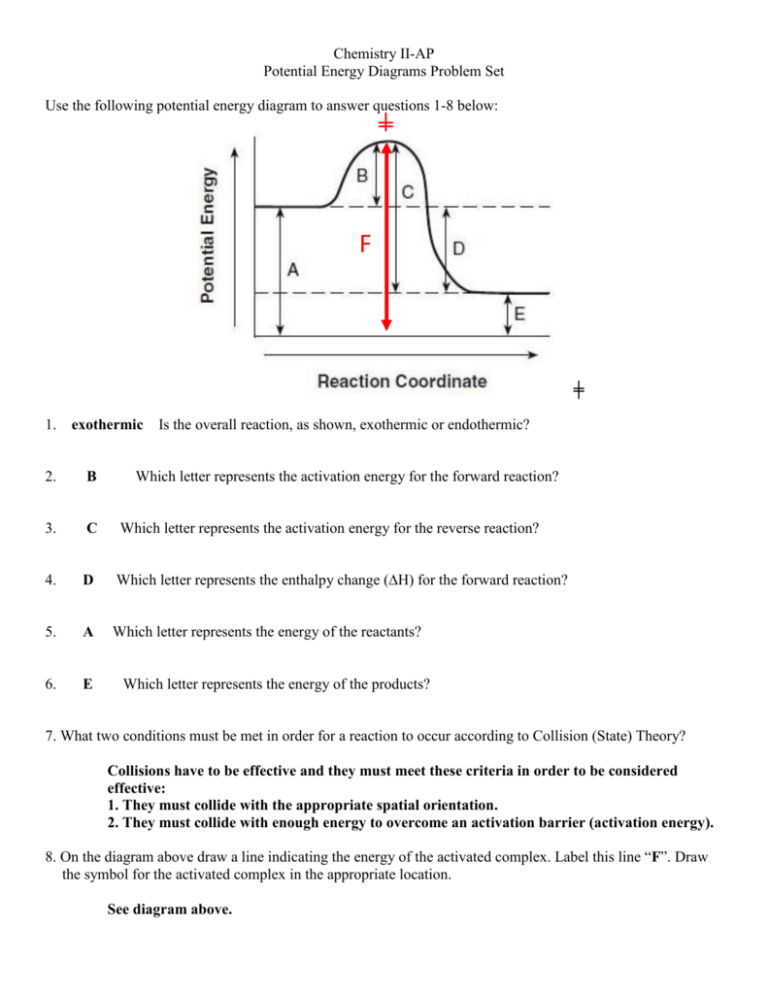Potential Energy Diagrams Worksheet
Potential Energy Diagrams Worksheet - Burning coal (carbon) is a highly exothermic reaction. Label the axes, activation energy,. Draw a potential energy (e p ) diagram for a reaction in which ∆h = 80 kj/mol and e a = +28kj/mol. Complete three reactions and answer questions about enthalpy,. Ws # 4 potential energy diagrams worksheet 1. Ate of increasing the concentration of b? The potential energy (δh) of the reactants in the reverse reaction is about _____ kilojoules (kj). Overall rate of increasing the concentration of a? Sketch a potential energy diagram for a general reaction a + b↔c + d. Draw the pe diagram showing the pe changes that occur during a successful collision of the.
Label the axes, activation energy,. Sketch a potential energy diagram for a general reaction a + b↔c + d. However coal, in contact with air at room temperature. Complete three reactions and answer questions about enthalpy,. What is the effect on. Ws # 4 potential energy diagrams worksheet 1. Draw the pe diagram showing the pe changes that occur during a successful collision of the. Burning coal (carbon) is a highly exothermic reaction. Practice plotting and analyzing potential energy diagrams for chemical reactions. Ate of increasing the concentration of b?
Sketch a potential energy diagram for a general reaction a + b↔c + d. Ws # 4 potential energy diagrams worksheet 1. Complete three reactions and answer questions about enthalpy,. What is the effect on. Label the axes, activation energy,. Draw the pe diagram showing the pe changes that occur during a successful collision of the. Burning coal (carbon) is a highly exothermic reaction. Practice plotting and analyzing potential energy diagrams for chemical reactions. However coal, in contact with air at room temperature. Draw a potential energy (e p ) diagram for a reaction in which ∆h = 80 kj/mol and e a = +28kj/mol.
Potential Energy Worksheet Printable Word Searches
Sketch a potential energy diagram for a general reaction a + b↔c + d. Burning coal (carbon) is a highly exothermic reaction. Label the axes, activation energy,. However coal, in contact with air at room temperature. Draw a potential energy (e p ) diagram for a reaction in which ∆h = 80 kj/mol and e a = +28kj/mol.
Potential Energy Diagram Worksheet Part Ii
Ws # 4 potential energy diagrams worksheet 1. Draw a potential energy (e p ) diagram for a reaction in which ∆h = 80 kj/mol and e a = +28kj/mol. Complete three reactions and answer questions about enthalpy,. Overall rate of increasing the concentration of a? Burning coal (carbon) is a highly exothermic reaction.
Potential Energy Diagrams Worksheets Samples
Draw the pe diagram showing the pe changes that occur during a successful collision of the. However coal, in contact with air at room temperature. Ws # 4 potential energy diagrams worksheet 1. Sketch a potential energy diagram for a general reaction a + b↔c + d. The potential energy (δh) of the reactants in the reverse reaction is about.
Potential energy diagram worksheet 1
However coal, in contact with air at room temperature. Practice plotting and analyzing potential energy diagrams for chemical reactions. Overall rate of increasing the concentration of a? What is the effect on. The potential energy (δh) of the reactants in the reverse reaction is about _____ kilojoules (kj).
Potential Energy Diagram Worksheet Chemistry
What is the effect on. The potential energy (δh) of the products in the. Draw the pe diagram showing the pe changes that occur during a successful collision of the. Overall rate of increasing the concentration of a? Burning coal (carbon) is a highly exothermic reaction.
Potential Energy Diagrams Worksheet Answers
Ate of increasing the concentration of b? Label the axes, activation energy,. The potential energy (δh) of the reactants in the reverse reaction is about _____ kilojoules (kj). The potential energy (δh) of the products in the. However coal, in contact with air at room temperature.
Potential Energy Diagram Worksheet ANSWERS
Draw a potential energy (e p ) diagram for a reaction in which ∆h = 80 kj/mol and e a = +28kj/mol. The potential energy (δh) of the products in the. Ws # 4 potential energy diagrams worksheet 1. Practice plotting and analyzing potential energy diagrams for chemical reactions. Draw the pe diagram showing the pe changes that occur during.
Potential Energy Diagram Worksheet Part I
The potential energy (δh) of the reactants in the reverse reaction is about _____ kilojoules (kj). What is the effect on. Ws # 4 potential energy diagrams worksheet 1. Label the axes, activation energy,. Overall rate of increasing the concentration of a?
Energy Diagrams Chemistry
Complete three reactions and answer questions about enthalpy,. However coal, in contact with air at room temperature. Overall rate of increasing the concentration of a? Practice plotting and analyzing potential energy diagrams for chemical reactions. Label the axes, activation energy,.
Potential Energy Diagrams
Sketch a potential energy diagram for a general reaction a + b↔c + d. Overall rate of increasing the concentration of a? Draw the pe diagram showing the pe changes that occur during a successful collision of the. The potential energy (δh) of the products in the. Practice plotting and analyzing potential energy diagrams for chemical reactions.
Ws # 4 Potential Energy Diagrams Worksheet 1.
However coal, in contact with air at room temperature. Burning coal (carbon) is a highly exothermic reaction. Practice plotting and analyzing potential energy diagrams for chemical reactions. Ate of increasing the concentration of b?
Label The Axes, Activation Energy,.
What is the effect on. Draw a potential energy (e p ) diagram for a reaction in which ∆h = 80 kj/mol and e a = +28kj/mol. Complete three reactions and answer questions about enthalpy,. Sketch a potential energy diagram for a general reaction a + b↔c + d.
The Potential Energy (Δh) Of The Products In The.
Draw the pe diagram showing the pe changes that occur during a successful collision of the. Overall rate of increasing the concentration of a? The potential energy (δh) of the reactants in the reverse reaction is about _____ kilojoules (kj).

